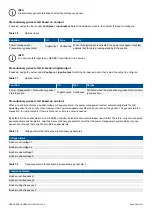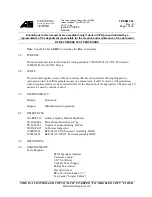
Trip
You can use
Trip
to avoid a situation where gensets with significantly different running times are over- or under-used. For example, if
Total
is used, then an older genset might not run at all until the newer gensets get up to the same number of running hours.
Example Swap timer for the Total and Trip methods
There are three gensets (A, B, C) in the system. The
Swap timer
is 100 hours. All the gensets have 0 running hours.
The following graph shows how the running hours priority determines which gensets run, as well as the effect when more than one
genset is required.
0
200
100
100
200
Time
[hours]
Genset
running
time
[hours]
A
B
C
1
2
Gensets
required
1
2
3
300
4
5
6
7
ABC
CBA
ACB
100
40
0
100
115
100
0
0
0
BCA
200
115
160
Priority
A hours
B hours
C hours
The operation is as follows:
1. The genset priority is A, B, C. Genset A runs.
2. At 60 hours, the load increases, and an additional genset is required. Genset B starts.
3. The swap timer reaches 100 hours. The genset priority changes to C, B, A. Genset C starts. Genset A stops.
4. At 175 hours, the load decreases, and only one genset is required. Genset B stops.
5. The swap timer reaches 200 hours. The genset priority changes to A, C, B. Genset A starts. Genset C stops.
6. At 240 hours, the load increases, and an additional genset is required. Genset B starts.
7. The swap timer reaches 300 hours. The genset priority changes to B, C, A. Genset B starts. Genset A stops.
7.3.6 Genset priority digital outputs
Controller type: GENSET controllers only.
You can configure a digital output with a function for the genset priority.
Assign the function to a digital output under
Configure > Input/output
. Select a hardware module with a digital output, then select
the output to configure.
DESIGNER'S HANDBOOK 4189340911K UK
Page 226 of 521
















































